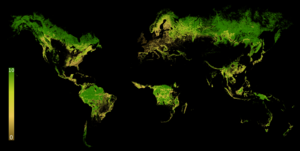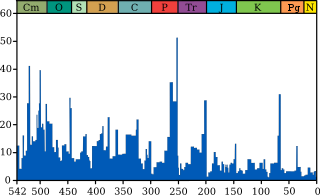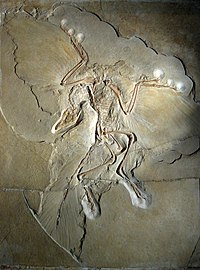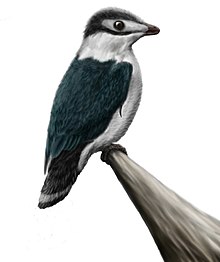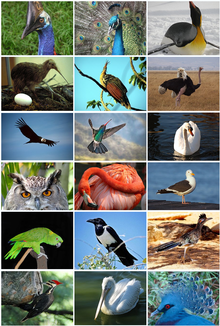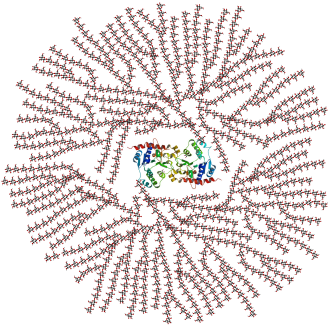Biodiversity loss includes the extinction of species (plant or animal) worldwide, as well as the local reduction or loss of species in a certain habitat, resulting in a loss of biological diversity.
The latter phenomenon can be temporary or permanent, depending on whether the environmental degradation that leads to the loss is reversible through ecological restoration/ecological resilience or effectively permanent (e.g. through land loss). Global extinction has so far been proven to be irreversible.
Even though permanent global species loss is a more dramatic and tragic phenomenon than regional changes in species composition, even minor changes from a healthy stable state can have dramatic influence on the food web and the food chain insofar as reductions in only one species can adversely affect the entire chain (coextinction), leading to an overall reduction in biodiversity, possible alternative stable states of an ecosystem notwithstanding. Ecological effects of biodiversity are usually counteracted by its loss. Reduced biodiversity in particular leads to reduced ecosystem services and eventually poses an immediate danger for food security, also for humankind.
Loss rate
You know, when we first set up WWF, our objective was to save endangered species from extinction. But we have failed completely; we haven’t managed to save a single one. If only we had put all that money into condoms, we might have done some good.
— Sir Peter Scott, Founder of the World Wide Fund for Nature, Cosmos Magazine, 2010
The current rate of global diversity loss is estimated to be 100 to 1000 times higher than the (naturally occurring) background extinction rate, faster than at any other time in human history, and expected to still grow in the upcoming years. These rapidly rising extinction trends impacting numerous animal groups including mammals, birds, reptiles, amphibians and ray-finned fishes have prompted scientists to declare a contemporary biodiversity crisis.
Locally bounded loss rates can be measured using species richness and its variation over time. Raw counts may not be as ecologically relevant as relative or absolute abundances. Taking into account the relative frequencies, a considerable number of biodiversity indexes has been developed. Besides richness, evenness and heterogeneity are considered to be the main dimensions along which diversity can be measured.
As with all diversity measures, it is essential to accurately classify the spatial and temporal scope of the observation. "Definitions tend to become less precise as the complexity of the subject increases and the associated spatial and temporal scales widen." Biodiversity itself is not a single concept but can be split up into various scales (e.g. ecosystem diversity vs. habitat diversity or even biodiversity vs. habitat diversity) or different subcategories (e.g. phylogenetic diversity, species diversity, genetic diversity, nucleotide diversity). The question of net loss in confined regions is often a matter of debate but longer observation times are generally thought to be beneficial to loss estimates.
To compare rates between different geographic regions latitudinal gradients in species diversity should also be considered.
Human-driven biodiversity loss and ecological effects
Biodiversity is traditionally defined as the variety of life on Earth in all its forms and it comprises the number of species, their genetic variation and the interaction of these lifeforms. However, from past few years the human-driven biodiversity loss are causing more severe and longer-lasting impacts. Examples of human-driven factors on biodiversity loss includes habitat alteration, pollution, and overexploitation of resources.
Change in land use
In 2006, many species were formally classified as rare or endangered or threatened; moreover, scientists have estimated that millions more species are at risk which have not been formally recognized. About 40 percent of the 40,177 species assessed using the IUCN Red List criteria are now listed as threatened with extinction—a total of 16,119.
Examples of changes in land use include deforestation, intensive monoculture, and urbanization.
The UN's Global Biodiversity Outlook 2014 estimates that 70 percent of the projected loss of terrestrial biodiversity are caused by agriculture use. Moreover, more than 1/3 of the planet's land surface is utilised for crops and grazing of livestock. Agriculture destroys biodiversity by converting natural habitats to intensely managed systems and by releasing pollutants, including greenhouse gases. Food value chains further amplify impacts including through energy use, transport and waste. The direct effects of urban growth on habitat loss are well understood:Building construction often results in habitat destruction and fragmentation. The rise of urbanization greatly reduced biodiversity when large areas of natural habitat are fragmented. Small habitat patches are unable to support the same level of genetic or taxonomic diversity as they formerly could while some of the more sensitive species may become locally extinct. According to a 2020 study published in Nature Sustainability, more than 17,000 species are at risk of losing habitat by 2050 as agriculture continues to expand in order to meet future food needs. The researchers suggest that greater agricultural efficiency in the developing world and large scale transitions to healthier, planet-based diets could help reduce habitat loss. Similarly, a 2021 Chatham House report also posited that a global shift towards largely plant-based diets would free up the land to allow for the restoration of ecosystems and biodiversity. Currently, around 80% of all global farmland used to rear cattle.
Pollution
Pollution from burning fossil fuels such as oil, coal and natural gas, can remain in the air as particle pollutants or fall to the ground as acid rain. Acid rain, which is primarily composed of sulfuric and nitric acid, causes acidification of lakes, streams and sensitive forest soils, and contributes to slower forest growth and tree damage at high elevations. Moreover, carbon dioxide released from burning fossil fuels and biomass, deforestation, and agricultural practices contributes to greenhouse gases, which prevent heat from escaping the Earth's surface. With the increase in temperature expected from increasing greenhouse gases, there will be higher levels of air pollution, greater variability in weather patterns, intensification of climate change effects, and changes in the distribution of vegetation in the landscape. These two factors play a huge role towards biodiversity loss and entirely depended on human-driven factors.
Invasive species and over exploitation
Invasive species have major implications on biodiversity loss and have degraded various ecosystems worldwide. Invasive species are migrant species that stand in the gap of native species by out competing them.
Human over harvesting of biodiversity example through over fishing will finally lead to their extinction.
Ecological effects of biodiversity loss
Biodiversity loss also threatens the structure and proper functioning of the ecosystem. Although all ecosystems are able to adapt to the stresses associated with reductions in biodiversity to some degree, biodiversity loss reduces an ecosystem's complexity, as roles once played by multiple interacting species or multiple interacting individuals are played by fewer or none. The effects of species loss or changes in composition, and the mechanisms by which the effects manifest themselves, can differ among ecosystem properties, ecosystem types, and pathways of potential community change. At higher levels of extinction (41 to 60 percent of species), the effects of species loss ranked with those of many other major drivers of environmental change, such as ozone pollution, acid deposition on forests and nutrient pollution. Finally, the effects are also seen on human needs such clean water, air and food production over-time. For example, studies over the last two decades have demonstrated that more biologically diverse ecosystems are more productive. As a result, there has been growing concern that the very high rates of modern extinctions – due to habitat loss, overharvesting and other human-caused environmental changes – could reduce nature's ability to provide goods and services like food, clean water and a stable climate.
An October 2020 analysis by Swiss Re found that one-fifth of all countries are at risk of ecosystem collapse as the result of anthropogenic habitat destruction and increased wildlife loss.
Factors
Major factors for biotic stress and the ensuing accelerating loss rate are, amongst other threats:
- Habitat loss and degradation
- Climate change through heat stress and drought stress
- Excessive nutrient load and other forms of pollution
- Over-exploitation and unsustainable use (e.g. unsustainable fishing methods) we are currently using 25% more natural resources than the planet
- Armed conflict, which disrupts human livelihoods and institutions, contributes to habitat loss, and intensifies over-exploitation of economically valuable species, leading to population declines and local extinctions.
- Invasive alien species that effectively compete for a niche, replacing indigenous species
- Human activity has left the Earth struggling to sustain life, due to the demands humans have. As well as leaving around 30% of mammal, amphibian, and bird species endangered.
Insect loss
In 2017, various publications describe the dramatic reduction in absolute insect biomass and number of species in Germany and North America over a period of 27 years. As possible reasons for the decline, the authors highlight neonicotinoids and other agrochemicals. Writing in the journal PLOS One, Hallman et al. (2017) conclude that "the widespread insect biomass decline is alarming."
Birds loss
Certain types of pesticides named Neonicotinoids probably contributing to decline of certain bird species. A study funded by BirdLife International confirms that 51 species of birds are critically endangered and 8 could be classified as extinct or in danger of extinction. Nearly 30% of extinction is due to hunting and trapping for the exotic pet trade. Deforestation, caused by unsustainable logging and agriculture, could be the next extinction driver, because birds lose their habitat and their food. The biologist Luisa Arnedo said: "as soon as the habitat is gone, they're gone too".
Earthworm loss
The critical decline of earthworms (with a mean of –83.3 %) has been recorded under non-ecological agricultural practices.
Freshwater fish loss
A study by 16 global conservation organizations found that the biodiversity crisis is most acute in freshwater ecosystems, with a rate of decline double that of oceans and forests. Global populations of freshwater fish are collapsing from anthropogenic impacts such as pollution and overfishing. Migratory fish populations have declined by 76% since 1970, and large "megafish" populations have fallen by 94% with 16 species declared extinct in 2020.
Food and agriculture
In 2019, the UN's Food and Agriculture Organization produced its first report on The State of the World’s Biodiversity for Food and Agriculture, which warned that "Many key components of biodiversity for food and agriculture at genetic, species and ecosystem levels are in decline." The report states that this is being caused by “a variety of drivers operating at a range of levels” and more specifically that “major global trends such as changes in climate, international markets and demography give rise to more immediate drivers such as land-use change, pollution and overuse of external inputs, overharvesting and the proliferation of invasive species. Interactions between drivers often exacerbate their effects on BFA [i.e. biodiversity for food and agriculture]. Demographic changes, urbanization, markets, trade and consumer preferences are reported [by the countries that provided inputs to the report] to have a strong influence on food systems, frequently with negative consequences for BFA and the ecosystem services it provides. However, such drivers are also reported to open opportunities to make food systems more sustainable, for example through the development of markets for biodiversity-friendly products.” It further states that “the driver mentioned by the highest number of countries as having negative effects on regulating and supporting ecosystem services [in food and agricultural production systems] is changes in land and water use and management” and that “loss and degradation of forest and aquatic ecosystems and, in many production systems, transition to intensive production of a reduced number of species, breeds and varieties, remain major drivers of loss of BFA and ecosystem services.”
The 2019 IPBES Global Assessment Report on Biodiversity and Ecosystem Services asserts that industrial agriculture is the primary driver collapsing biodiversity. The health of humans is largely dependent on the product of an ecosystem. With biodiversity loss, a huge impact on human health comes as well. Biodiversity makes it possible for humans to have a sustainable level of soils and the means to have the genetic factors in order to have food.
Many activists and scholars have suggested that there is a connection between plant patent protection and the loss of crop biodiversity, although such claims are contested.
Native species richness loss
Humans have altered plant richness in regional landscapes worldwide transforming more than 75% of the terrestrial biomes to the "anthropogenic biomes." This is seen through loss of native species being replaced and out competed by agriculture. Models indicate that about half of the biosphere has seen a "substantial net anthropogenic change" in species richness.
Solutions
There are so many conservation challenges when dealing with biodiversity loss that a joint effort needs to be made through public policies, economic solutions, monitoring and education by governments, NGOs, conservationists etc. Incentives are required to protect species and conserve their natural habitat and disincentivize habitat loss and degradation (e.g. implementing sustainable development including targets of SDG 15). Other ways to achieve this goal are enforcing laws that prevent poaching wildlife, protect species from overhunting and overfishing and keep the ecosystems they rely on intact and secure from species invasions and land use conversion.
Environmental organizations
There are many organizations devoted to the cause of prioritizing conservation efforts such as the Red List of Threatened Species from the International Union for Conservation of Nature and Natural Resources (IUCN) and the United States Endangered Species Act. British environmental scientist Norman Myers and his colleagues have identified 25 terrestrial biodiversity hotspots that could serve as priorities for habitat protection.
Many governments in the world have conserved portions of their territories under the Convention on Biological Diversity (CBD), a multilateral treaty signed in 1992–3. The 20 Aichi Biodiversity Targets, part of the CBD's Strategic Plan 2011–2020, were published in 2010. Since 2010, approximately 164 countries have developed plans to reach their conservation targets, including the protection of 17 percent of terrestrial and inland waters and 10 percent of coastal and marine areas.
In 2019 the Intergovernmental Science-Policy Platform on Biodiversity and Ecosystem Services (IPBES), an international organization, reported that up to a million plant and animal species are facing extinction because of human activities. An October 2020 report by IPBES stated that the same human activities which are the underlying drivers of climate change and biodiversity loss, such as the destruction of wildlife and wild habitats, are also the same drivers of pandemics, including the COVID-19 pandemic.
According to the 2020 United Nations' Global Biodiversity Outlook report, of the 20 biodiversity goals laid out by the Aichi Biodiversity Targets in 2010, only 6 were "partially achieved" by the deadline of 2020. The report highlighted that if the status quo is not changed, biodiversity will continue to decline due to "currently unsustainable patterns of production and consumption, population growth and technological developments". The report also singled out Australia, Brazil and Cameroon and the Galapagos Islands (Ecuador) for having had one of its animals lost to extinction in the past 10 years. Following this, the leaders of 64 nations and the European Union pledged to halt environmental degradation and restore the natural world. Leaders from some of the world's biggest polluters, namely China, India, Russia, Brazil and the United States, were not among them. Some top scientists say that even if the targets had been met, it likely would not have resulted in any substantive reductions of current extinction rates.
In 2020, with passing of the 2020 target date for the Aichi Biodiversity Targets, scientists proposed a measurable, near-term biodiversity target - comparable to the below 2°C global warming target - of keeping described species extinctions to well below 20 per year over the next 100 years across all major groups (fungi, plants, invertebrates, and vertebrates) and across all ecosystem types (marine, freshwater, and terrestrial).


